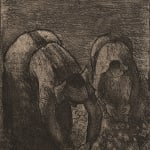Camille Pissarro (1831-1903)
Peasant Women in a Field of Beans (Paysannes dans un Champ de Haricots), 1891
Etching, aquatint, and manière grise on laid paper
241 x 156 mm. (9 1/2 x 6 1/8 inches)
Signed, titled & annotated '1er etat no. 10', also marked with a large Z by the artist in pencil
Delteil 103 only state
Delteil notes that there were 14 lifetime proofs. (there were also 18 posthumous impressions.) Pissarro's annotation indicates that this was a first state; no other state is known. Although Delteil...
Delteil notes that there were 14 lifetime proofs. (there were also 18 posthumous impressions.)
Pissarro's annotation indicates that this was a first state; no other state is known. Although Delteil notes that there were 14 lifetime impressions, he accounts for only a few at the Musée du Luxembourg, Bibliothque Nationale, Paris, and the Ashmolean Museum, Oxford.
Pissarro was perhaps the most active printmaker of the Impressionists; printmaking was an essential component of his career, and he was deeply involved in the process of creating and printing his prints. By mid-career Pissarro had made many etchings, using fairly conventional techniques (although of course aesthetically his work was hardly conventional), but it was Degas who introduced Pissarro to a range of unusual ways of working with the etching plate especially the use of aquatint. Among other innovations, they developed a variant of the aquatint technique called manière grise in which they scraped the plate with an emery point; that technique appears to have been used in this print.
Pissarro did not like professional printing of his etchings, and so he printed his plates himself (also Degas apparently printed many Pissarro proofs). The concept was not to produce a large edition of prints similar in appearance (only about 5 of Pissarro’s prints were in fact editioned during his lifetime); printmaking for Pissarro was a way of experimenting, achieving variations in light, mood, sensibility, with each proof. He did not intend to earn much money through printmaking (and he never did).
Pissarro's annotation indicates that this was a first state; no other state is known. Although Delteil notes that there were 14 lifetime impressions, he accounts for only a few at the Musée du Luxembourg, Bibliothque Nationale, Paris, and the Ashmolean Museum, Oxford.
Pissarro was perhaps the most active printmaker of the Impressionists; printmaking was an essential component of his career, and he was deeply involved in the process of creating and printing his prints. By mid-career Pissarro had made many etchings, using fairly conventional techniques (although of course aesthetically his work was hardly conventional), but it was Degas who introduced Pissarro to a range of unusual ways of working with the etching plate especially the use of aquatint. Among other innovations, they developed a variant of the aquatint technique called manière grise in which they scraped the plate with an emery point; that technique appears to have been used in this print.
Pissarro did not like professional printing of his etchings, and so he printed his plates himself (also Degas apparently printed many Pissarro proofs). The concept was not to produce a large edition of prints similar in appearance (only about 5 of Pissarro’s prints were in fact editioned during his lifetime); printmaking for Pissarro was a way of experimenting, achieving variations in light, mood, sensibility, with each proof. He did not intend to earn much money through printmaking (and he never did).



